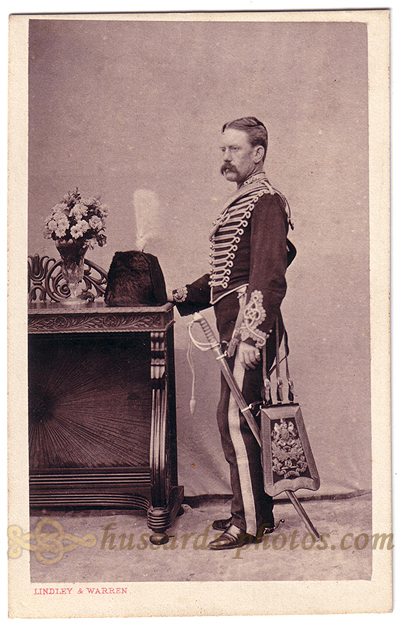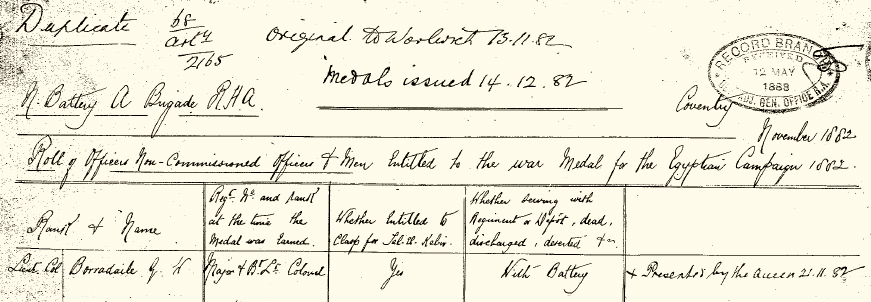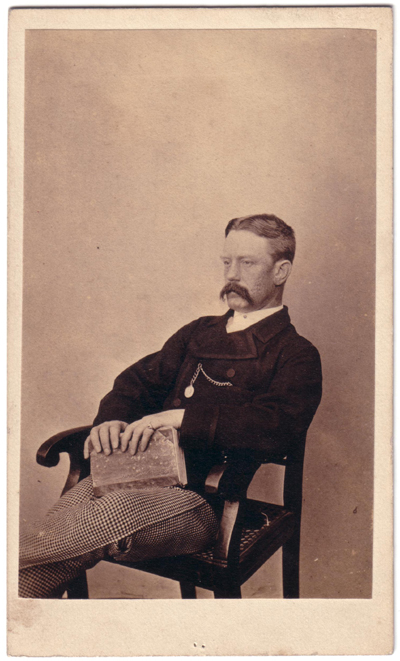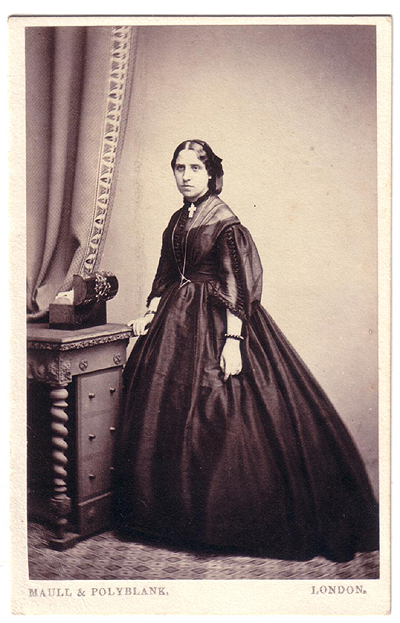|
Carte-de-Visite,
studio Lindley
& Warren, Bombay
George
William Borradaile
as
a Captain in the Royal Horse Artillery (see also this group
photograph) |
George
W. Borradaile was the son of Harry Borradaile, Esq., Bombay Civil
Service. Born 13th 1838 at Poona, he was his fourth child (and
third son). He was educated at a
private school and at Cheltenham College, then entered the
Military Seminary of the East India Company at Addiscombe in 1856,
and passed out as a Bombay Artillery cadet in the following year. George
W. Borradaile
became a Second Lieutenant in the Bombay Horse Artillery on
December, 11th 1857. He was promoted to first Lieutenant on April
27th, 1858. As most of the troops from the Bombay Presidency he didn't see active service during the
Indian Mutiny, that was to end by mid-1858. He
was transferred to the Royal Horse Artillery when the HEIC Army
was amalgamated in 1862 - the ex-Bombay Horse Artillery becoming
the 4th Horse Brigade. The Bombay Horse Artillery Batteries were
already organized along the same lines as the RHA, so its
operationnal organization was not much affected by the
amalgamation.
In 1864 the Horse Artillery was reorganized and the 4th Horse
Brigade was renamed E Brigade. On 3rd
November 1864, at Ahmednuggur, the Reverend E. N. Dickenson
celebrated his mariage to Catherine Cornelia Straker ("Kate"
to the family, as noted by her portrait - see photograph bottom
right),
third daughter of the late Charles Doyle Straker, MD, CB,
Physician General Bombay Army. They had a daughter, later married
to Edmund Charles Cox. catherine Cornelia died in 1912. On
August 3rd, 1865 he is promoted to 2nd Captain in A Battery E
Brigade. In 1871, E
Brigade was reduced, and its batteries transferred to other
Brigades : Batteries A and B batteries were transferred to D Brigade
(respectively becoming C and E Batteries), and C and D Batteries transferred
to C Brigade (respectively becoming G and H). George William
Borradaile is thus affected to C Battery D Brigade now, and will
be instructedby Horse
Guards to at Woolwich in January
1873 . That Battery,
along with the other Batteries of D Brigade (former Madras Horse Artillery),
had come back from India in December 1872 (it seems that our man
had somehow rejoined England earlier).
In april 1874, C Battery, D Brigade left
Woolwich to proceed for Ireland. In 1875 George William Borradaile
is promoted to Major (July 14th,
1875) and leaves his C Battery at Newbridge to be appointed
to the command of C battery, 25th Brigade, Royal Artillery, at
Devonport. The regimental rank of
Major (suppressed in 1827) had been reintroduced in 1872 in the
Royal Artillery, as the rank for officers commanding Batteries,
and an answer to the problems of promotion in the Regiment of
Royal Artillery. His appointment to a Battery of Royal Artillery
as his first command is quite the usual way up : all appointments
to the Elite Royal Horse Artillery were Senior appointments,
within a Regiment where Seniority was quite the rule.
His Battery is however at once involved in important
Field Artillery Experiments at Okehampton camp.
|
The Times reports : Okehampton,
Aug. 4
(...) The C Battery, commanded by major Borradaile numbers 91 men
and 59 horses, with six 16-pounder M.L.R. guns of 12cwt., firing
3lb. of powder. Both men and horses are in excellent condition
(...) Okehampton,
Aug. 17
The experiments were resumed yesterday under more favourable
circumstances as regards weather than have yet been experienced
down here, the day being fine and somewhat more than warm. The
object of the trials was to accustom Batteries to manoeuvre over
the ground and to use their range-finding instruments with
facility. The
Times, Oct 07 1875
(...) We may commence by saying that the Okehampton experiments
have been a great success.(...)
(...) the experiments were instituted for the purpose of
determining various points connected with the efficient service of
our rifled field artillery under conditions as similar as possible
to those which may occur on servic, namely :
1. the relative effects produced by the fire of a field battery
when the distance is judged by eye and when the range is
determined by a range-finder.
2. The results of artillery fire against the most recent formation
in which troops will attack, and the nature of projectile which,
under different conditions of ground and distance, may be expected
to produce the maximum effect.
3. The effect of artillery fire against artillery matériel both
in the open and when protected by gunpits (...)
The manner in which the battery served their guns on this occasion
deserved the admiration of all whow itnessed it. Indeed, the
shooting of both the batteries at Okehampton- namely, E Battery E
Brigade Royal Horse Artillery, commanded by Major Holberton, and C
Battery 25th Brigade Royal Artillery, commanded by Major
Borradaile- leaves now little to be desired. These batteries,
moreover, were not specially selected, but were taken because they
happened to be stationed nea the spot - the Horse Artillery at
Exeter, the field battery at Devonport. We may, therefore, accept
them as fairly representing our Field Artillery when they joined
the camp on Dartmoor. Now, however,they have gained an experience
the value of which it would be difficult to over-estimate.(...)
Let us hope, therefore, that the Okehampton experiments will prove
an epoch in the history of Field artillery instruction, and that
the present trials will only be the first of our Annual Artillery Manuvres.
|
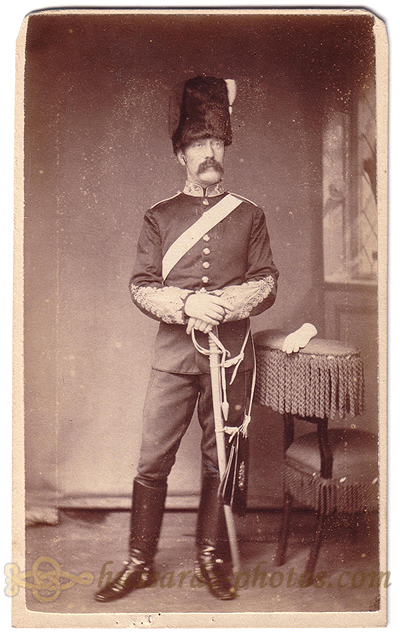
|
|
Carte-de-Visite,
the Alexandra Studio,
Sheerness on Sea
G.W. Borradaile as a Major in the Royal Artillery
|
By 1879 George William Borradaile had been appointed back to the
Royal Horse Artillery : The Times, Oct 07 1879, reports an
inspection by the Duke of Cambridge of the troops at Woolwich,
stating that Major G.W. Borradaile was now in command of E Battery,
C Brigade, R.H.A. In May 1880 his battery was transfered from
Woolwich to Canterbury.
The
following year Major Borradaile's Battery was ordered to proceed
to Natal to take part in the first Boer War in Transvaal. The
Battery embarked the Persian Monarch in the Royal Albert Docks,
North Woolwich, on March 15 1881. The Battery, arriving from
Canterbury, embarked full strength with 199 Non Commissioned
Officers and men, six nine-pounders muzzle loading guns, 10 wagons
and 203 horses, and 900 rounds of ammunition for the guns. The
British government had however signed a truce on March 6,
and the final peace treaty was to be signed on March 23, 1881 (giving
the Boers self-government in the Transvaal under a theoretical
British oversight). Major Borradaile's Battery, en route to
Natal, was ordered back to England on April 6. As in 1858
George William Borradaile had nearly taken part in a
conflict. He didn't have to wait
long for another opportunity : the following year saw his Battery
(now renamed N Battery A Brigade after the early 1882
reorganization) ordered to Egypt : The
Times, August 5 1882
The first departure of troops from Southampton for the expedition
in Egypt took place yesterday, when the N Battery A Brigade Royal
Horse Artillery embarked on board the Tower Hill (Transport No.7),
a fine steamer of 4,021 gross tonnage, commanded by Captain
Barnett. (...) The total strength on board consists of 14 officers,
179 men, 176 horses, six guns, and six wagons. (...) The
Tower Hill reached Alexandria on August 16. The Battery was soon
to be engaged : in the first fight of the campaign, on August
24th, near Tel-El-Mahuta, two of the guns of N Battery,
under Lieutenant Hickman, distinguished themselves on the Sweet
Water Canal :
"This infinetesimal detachment of English
artillery held at bay the 12 Egyptian guns, and were reported by
Lord Wolseley as having repulsed infantry attacks both in front
and on the flanks during the day. The good stuff of which the men
were composed was shown by the fact that, when exhausted by their
labours under the awful heat of the sun above andits reflection
from the sand, they had water poured on their heads and again
faced the enemy" (The Times, jan , 1883)
The guns were 13-pounders muzzle loaders. The Battery was attached
to the Heavy Cavalry (also comprising three squadrons of Household
Cavalry,the 4th Dragoon Guards, and the 7th
Dragoon Guards), and the remaining four guns were in support
at Mahsamet. Onthe 25th they prepared by their fire the moonlight
charge of the Heavy Cavalry. On
September 9th the Battery took part in the action at Kassassin and
battle of Tel-el-Kebir. The
campaign was short lived, and Brevet Lieutenant-Colonel Borrdaile
was mentioned in the september 24 1882 despatch by the General
Officer Commanding in Egypt, Sir Garnet Wolseley :
"18. General Drury-Lowe also speaks in the
highest praise of Lieutenant-Colonel G.B.(sic) Borradaile, Royal
Horse Artillery, who ably commanded the battery permanently
attached to his division." The
N Battery A Brigade embarked on board the Tower Hill in the
beginning of October on their way back, reaching Portsmouth on
October 18th. George William
Borradaile was thus at last entitled to his first Campaign Medal (with Tel-el-Kebir Clasp).
The Medal Roll tells us that he was
presented his Medal by the Queen. He was also appointed "Ordinary
Member of the Military Division of the Third Class, or Companion,
of the Most Honourable Order of the Bath" on November 17,
1882. He was presented the Order by the Queen on November 23. He
was also awarded the Khedive Star, and the third class order of
the Medjidie.
|
|
